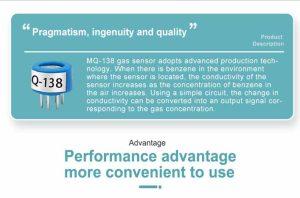Indoor air quality (IAQ) is a critical factor in ensuring a healthy and comfortable living environment. Poor IAQ can lead to various health issues, including allergies, respiratory problems, and even long-term chronic conditions. To address this concern, cutting-edge gas sensors have emerged as powerful tools in monitoring and enhancing indoor air quality. This article explores the importance of gas sensors in improving IAQ and highlights their potential benefits in creating healthier indoor environments.

Understanding Gas Sensors for IAQ:
Gas sensors designed for IAQ monitoring are sophisticated devices that detect and measure the concentration of specific gases and volatile organic compounds (VOCs) in indoor environments. These sensors employ advanced technologies such as electrochemical, semiconductor, and optical sensors to efficiently detect pollutants like carbon dioxide (CO2), carbon monoxide (CO), nitrogen dioxide (NO2), formaldehyde (HCHO), and various VOCs. Gas sensors provide real-time data on IAQ parameters, allowing for timely interventions and improvements.
Detecting Harmful Gases and VOCs:
Gas sensors enable the detection of harmful gases and VOCs that can adversely affect IAQ. Elevated levels of carbon dioxide, for example, can indicate poor ventilation, while high concentrations of VOCs can result from building materials, cleaning products, or off-gassing from furniture and carpets. By continuously monitoring these pollutants, gas sensors provide instant feedback on IAQ, enabling proactive measures to be taken to mitigate potential health risks.
Monitoring Ventilation Efficiency:
Proper ventilation is essential in maintaining good IAQ. Gas sensors can assess the efficiency of ventilation systems by measuring carbon dioxide levels. High CO2 concentrations indicate inadequate ventilation, potentially leading to stale air and an increased risk of airborne contaminants. By monitoring CO2 levels, gas sensors can prompt the adjustment of ventilation rates, ensuring a constant supply of fresh air and improving IAQ.
Early Detection of Carbon Monoxide:
Carbon monoxide (CO) is an odorless, colorless gas that can be deadly in high concentrations. Gas sensors equipped with CO detectors provide early detection of this silent killer, triggering alarms when unsafe levels are detected. By promptly alerting occupants to the presence of CO, gas sensors help prevent the risk of carbon monoxide poisoning and ensure a safer indoor environment.
Assessing Formaldehyde Levels:
Formaldehyde is a common indoor air pollutant emitted by building materials, furniture, and household products. Prolonged exposure to formaldehyde can cause health issues such as respiratory irritation and even cancer. Gas sensors that specifically measure formaldehyde levels can help identify potential sources of this harmful chemical. By monitoring formaldehyde concentrations, prompt actions can be taken to reduce exposure and improve IAQ.
Personalized Comfort and Wellness:
Gas sensors can contribute to personalized comfort and wellness by monitoring IAQ parameters. For example, by continuously monitoring temperature, humidity, and CO2 levels, gas sensors can provide data that facilitates the optimization of HVAC systems for ideal indoor conditions. Additionally, gas sensors can be integrated into smart home systems, allowing occupants to receive real-time IAQ information and adjust settings for optimal comfort and well-being.
Smart Building Integration:
Cutting-edge gas sensor technologies can be seamlessly integrated into smart building systems, enhancing IAQ management. These sensors can communicate with ventilation, heating, and cooling systems, automatically adjusting settings based on real-time IAQ data. By continuously monitoring and maintaining optimal IAQ levels, gas sensors help create healthier indoor environments while maximizing energy efficiency.

Conclusion:
Cutting-edge gas sensors play a crucial role in enhancing indoor air quality by detecting and measuring harmful gases and VOCs. With their ability to provide real-time data, these sensors empower individuals and building managers to take proactive measures to improve IAQ. By leveraging gas sensors to monitor ventilation efficiency, detect carbon monoxide, assess formaldehyde levels, and personalize comfort settings, we can create healthier indoor environments that promote well-being and productivity. As we continue to strive for sustainable, energy-efficient buildings, the integration of cutting-edge gas sensor technologies will be instrumental in achieving optimal IAQ standards and ensuring a healthier future.
 : +86 155 8830 2704
: +86 155 8830 2704 : jxdziot@gmail.com
: jxdziot@gmail.com
